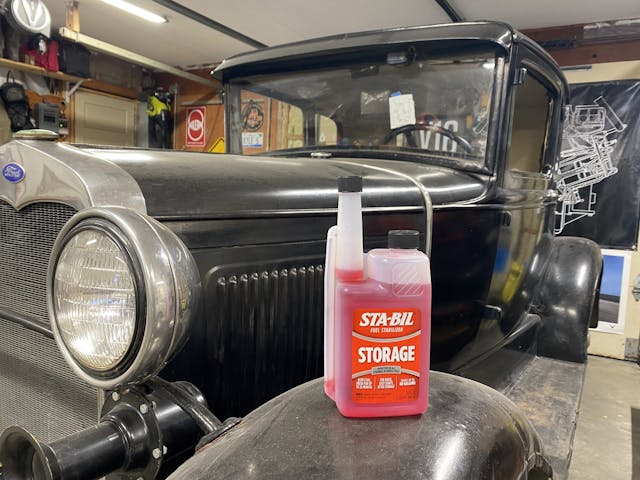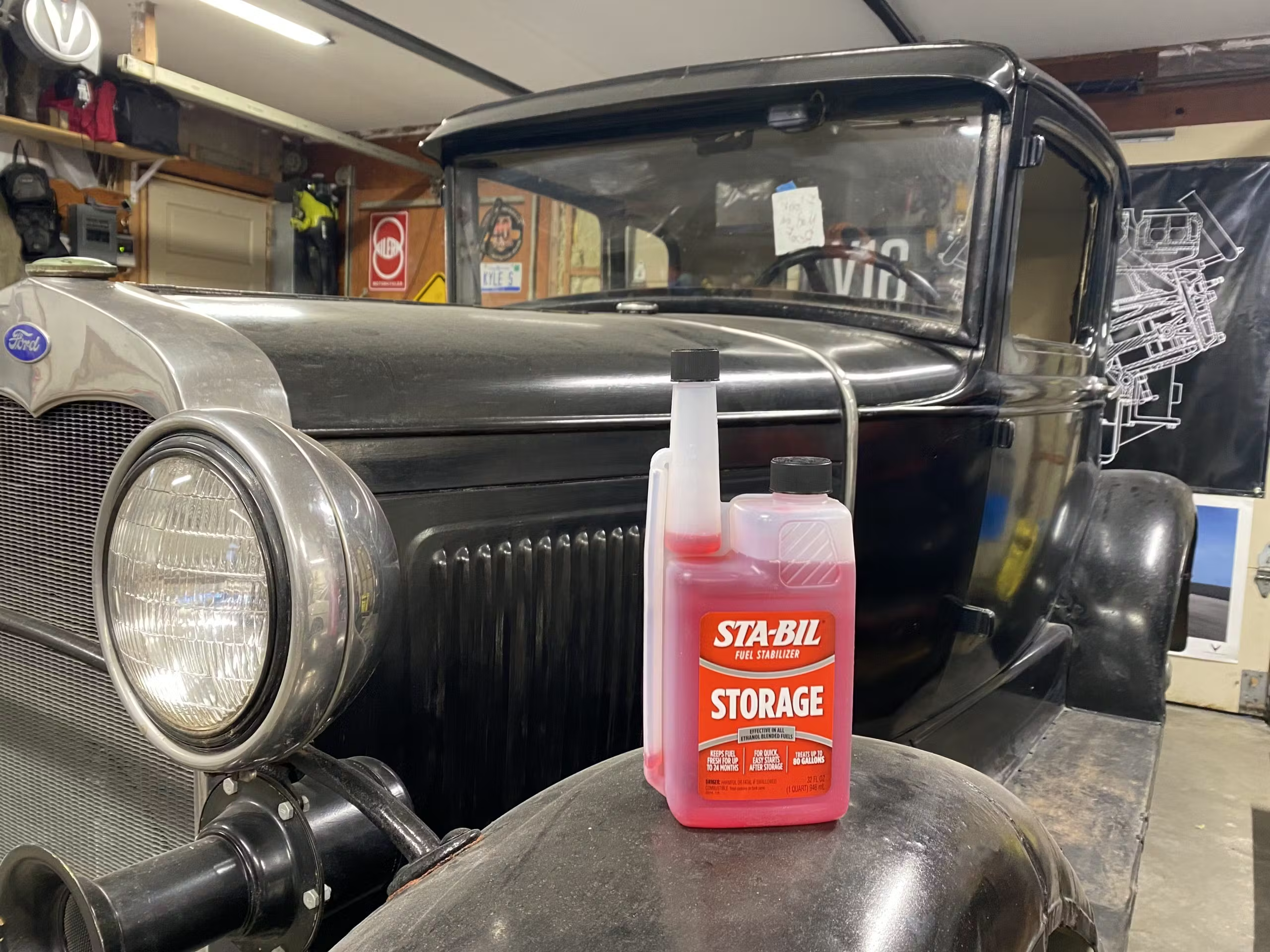Media | Articles
Is your fuel stabilizer actually hurting your car?
Putting your beloved ride away for the season and enduring months of watching it sit in place, wishing you could just go for a drive, is an unfortunate reality of winter vehicle storage. Worse is the notion that your careful storage prep routine includes a common misstep that will set you up for a bad experience come springtime. That’s exactly what FortNine digs into with this latest video about fuel stabilizers:
I am usually the first to throw shade at YouTube “tests” conducted using far from bulletproof science, but even these informal tests shed thought-provoking light on how different chemical compounds affect your car’s performance.
These fuel stabilizers typically have bold claims printed on the label, designed to appeal to the type of person who cares more about protecting their engine than buying the right pet food. I know I am more particular about the fuel I feed my internal combustion companions than the food I feed my fluffy cat friends, but as this video explains, one group has a lot less side effects from corn content.
The ethanol in modern fuel is hygroscopic, meaning it attracts water. That H2O content can reach a point where it will separate from the fuel, especially in long term storage. That water sitting at the bottom of the tank is the first thing to be picked up by the fuel pickup. To address this, the stabilizer concoctions work to lower fuel’s ability to pick up that moisture. They might also add some type of alcohol so that the heavier mixture will burn—however poorly—when drawn into the fuel system and dispersed in the combustion chamber.
Marketplace
Buy and sell classics with confidence
Yes, almost all of these mixtures help in some fashion, but a few caused damage in other ways compared to the test’s control sample. A few of the products tested led to greater corrosion, due to a lack of additive preventing the growth of rust and allowing a greater ingress of moisture. That moisture will—at best—make for a hard starting car in the spring and a rusty mess of a fuel system if left alone too long. Our vintage cars often have steel fuel lines and tanks, so any moisture just sitting around is bound to cause trouble.
In the end, the best solution with a vintage engine is to start with non-ethanol fuel. Fuel blends contain a lot of additives already and, as pointed out in the video, if there was one miracle cure that could be added to fuel to prevent all such problems, it would likely already be in the gas from the pump. Ethanol is what causes most of the problems associated with long-term fuel storage in an old car or bike. Barring the option of getting pure gas (also known as recreation gas), K100 and STA-BIL came out on top as recommended from the products sampled because STA-BIL and K100 both reduced the absorption of moisture and reduced corrosion.
Personally, this puts my mind at ease because as I have been a STA-BIL fan for years. Of course, I’ve never had more than my own anecdotal evidence to back up a recommendation, and I am often adding it to ethanol-free fuels from the outset. Now go forth and store with confidence! Hopefully spring arrives sooner than later.






Just don’t use more Stabil than recommended it turns to what looks like frog eggs in carburetor fuel bowls that plugs up jets. They will dissolve when air gets to them after opening up the carb. When using fuel with ethanol I store with with a 50/50 mix of Stabil and Marvel Mystery Oil When using ethanol free I use Marvel only. You can’t put to much an it coats fuel system if there is any evaporation. Ever see a corroded two stroke?
Thanks for this write up.
BMW Motorrad uses K100 in the tank from the factory, and that is good enough for me.
Also, with other products such as Stabil, when I have spilled some on my hands they leave a very oily petroleum type film which I have to wash off with a lot of hand soap.
K100 rinses off with water, telling me it mixes with water-isn’t that the goal?
Thanks for sending this silly video just after we parked them for the winter. The video was annoying at best.
If you accidentally add twice as much sta-bil to your truck gas tank? Would adding a lead additive help?
I have several machines that go long stretches w/o using, 63 Chevy Impala 283ci, 2003 Buick Park Ave V6, Generac twin 17500w gen, and a twin cyl Cub Cadet lawn tractor. The only fuel these machines ever get is non-ethanol with reg Sta-Bil (3 oz per 5 gal) and over the yrs I’ve never had any fuel related issues. My bro has a large nice Harley but it sat idle the whole of last winter, after I had told him the dangers of using ethanol gas. So warm weather arrived and his bike wouldnt start. The dealer told him not to use E10 gas after he wrote them a ck for $800 bucks. Now he uses non-ethanol and now say he’s gonna stabil nxt winter,we shall see if he’s learned anything.
I have a story! Yesterday I tried to start my chainsaw and try as I might it would not start. So last evening I put a half ounce of Sta-Bil in the tank just to see if it would help. Today I connected a spark plug tester with the light in line and pulled the cord. The chainsaw had spark alright and it started right up without using the choke. Scarred me a bit but a happy bit. I can’t say anything bad about Sta-Bil. I’ve been using it in six vehicles and two chainsaws for years for storage over winter. Last fall I forgot the chainsaws!!
I agree with your mentioning of the Hygroscopic Fuel effects, which cause rust. My 39 Ford, which I built from 1973 through 1975 sat from 1999 -2013, untouched on jack stands. I was able to start it up after the usual new battery, pump-bowl and screen cleanout, and Carburetor Float Chamber inspection, which revealed some minor powder residue from the evaporated gas. It started up and ran as well as it did in ’99. However, after the separate gas can fuel additions, I see now, the car progressively suffered damage to the fuel pump, and flexible fuel supply hose, in that the interior of the hose became constricted from the deterioration. The gas tank was etched and “Sloshed” by me with an aviation-grade sealant in 1999, but I have a new Drake tank ready to go in, along with a new fuel line I must fabricate and replace the steel line I put in in 1975. Now that you all figured-out I must be in my 70’s (71) by now, I did not lose the ambition to get this car going, but it is frustrating to see the damage. To narrow down the culprits, I am using a separate small fuel reservoir, with a 1/4-inch line with a compression fitting connected to the new flexible fuel hose. In that way the pump with have full suction. I even stocked up on spare fuel pumps and fuel hoses. My question, does the Sta-Bil neutralize the damage I have outlined here? I use TruFuel in my snowblower and it starts each year. Does the Sta-bil only nullify the moisture issues which cause rust or help with the deleterious effects of the ethanol fuel?